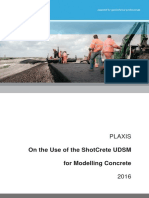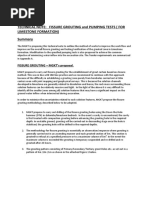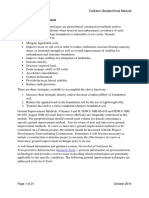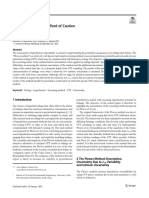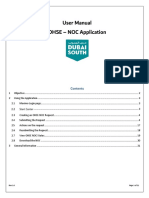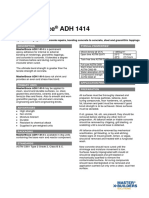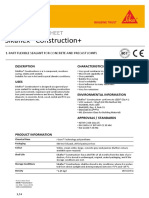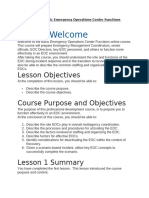Probe Test
Uploaded by
Azhar ShaikhProbe Test
Uploaded by
Azhar ShaikhG&P GEOTECHNICS SDN BHD
Specification for Cavity and Slumpzone Probing and Compaction Grout Treatment
7 October 1999
SPECIFICATION FOR CAVITY AND SLUMPZONE PROBING AND
COMPACTION GROUT TREATMENT
1.0
GENERAL REQUIREMENTS
This specification is to be read in conjunction with the contract, the general specification and all
other specifications and drawings. The Contractor shall design and carry out compaction
grouting of slumpzone, soft or loose soils and voids, above and between rock layers to ensure
that the areas and depths specified for such treatment shall be so treated as to comply with the
Criteria of Acceptance.
In the event that the provisions of other specification clauses cause ambiguity or conflict with the
requirements of this specification, the latter shall take precedence unless otherwise approved
by the Engineer.
Where works are ordered to be performed by the Contractor, but are not specified in these
specifications, the Contractor shall carry them out with full diligence and expedience as are
expected for works of this nature.
2.0
CODES AND STANDARDS
The design and construction where relevant shall be carried out in accordance with good
engineering practice and shall comply with the latest applicable Malaysian, British or ASTM
Standards and generally including the following:
BS 8004 : 1986
BS 5930 : 1981
BS 8110 : 1985
MS 522 : 1979
ASTM: D2113 83 : 1987
Code of Practice for Foundations
Code of Practice for Site Investigation
Code of Practice for Structural Use of Concrete
Specification for Portland Cement
Diamond Drilling for Soil Investigation
In the event when conflicting requirements occur in different Standards, the most stringent
standard shall take precedence.
3.0
SUBMITTALS
Before commencement of the work, the Contractor shall submit to the Engineer for his approval
legible points of shop drawing, method statement and design calculations of the proposed
treatment. The method statement should include detailed procedures for probing, treatment
and full descriptions of the procedures, equipment and materials to be used.
After completion of works at site, the Contractor shall submit complete reports (6 copies) of the
probing and treatment that include actual locations of cavity/slump zone, summary of drilling
records with rate of drilling, anomalies and full details of materials used, pumping pressure and
other relevant information listed in Section 17.0.
4.0
CAVITY AND SLUMPZONE PROBING
The Contractor should propose the drilling method to the Engineer for approval prior to work at
site. The drilling method proposed must have minimum effect of the surrounding soil and will
not cause subsidence and loosening of the adjacent subsoil. The drillhole shall be stabilised
PCG1
G&P GEOTECHNICS SDN BHD
Specification for Cavity and Slumpzone Probing and Compaction Grout Treatment
7 October 1999
with drilling fluid of bentonite or polymer slurry unless otherwise agreed by the Engineer. The
head of the drilling fluid shall be kept at a level high enough to ensure sufficient stabilising
capacity in the cased or uncased drillholes.
The depth of probing into limestone bedrock shall be a minimum of 10m if no cavity is
encountered and 10m below the last cavity encountered unless otherwise directed by the
Engineer. The boring of soil below cavity roof or overhang shall be considered as boring in soil
and shall not be considered as coring in rock. Standard penetration tests (SPT) shall be carried
out in all cavities with soil at interval of 1m until the next layer of rock is encountered. The
Contractor will only be allowed not to carry out SPT in cavity if the drilling and treatment is to be
carried out simultaneously using method and equipment approved by the Engineer.
The penetration speed of the cavity probing shall be recorded in every 1.0m penetration
intervals starting from the ground level. The occurrence of slumpzone above rock or cavities
within the limestone strata will be determined upon a sudden increase of penetration speed.
The Engineer will decide whether to treat the slumpzone or cavities based on the penetration
speed records submitted by the Contractor. The Contractor shall plot the penetration speed
versus depth and submit or fax the plot together with the data to the Engineer immediately after
drilling so that the Engineer can decide on the treatment. If the penetration speed are not
properly recorded and submitted to the Engineer in time for his decision on treatment, the
Engineer can reject the hole and a replacement hole has to be carried out by the Contractor
with no claim of extension of time and addition cost.
The diameter of the drillhole shall be large enough to allow compaction grout to be carried out
immediately after reaching the required level without having to redrill the hole after probing of
cavities. The diameter of the drillhole shall be proposed by the Contractor and approved by the
Engineer. If treatment of slumpzone and cavity is not required, the drill hole shall be properly
backfilled with cement-grout (W/C = 0.6) or low strength sand-cement mortar to the existing
ground level.
5.0
SPECIALIST SUBCONTRACTOR
Compactions grouting shall be carried out by experienced specialist subcontractors who have
previously carried out this treatment successfully and to the agreement of the Engineer. The
Specialist Subcontractor shall
(i)
6.0
have successfully carried out compaction grouting of a similar nature previously;
(ii)
possess equipment for cavity probing and compaction grouting required in
this contract.
PERSONNEL
The Specialist Subcontractor shall employ sufficient of experience personnel who are familiar
with the type of cavity probing and compaction grouting described in this contract. All
personnel shall be to the agreement of the Engineer.
7.0
CRITERIA FOR ACCEPTANCE
Each treatment location shall be advanced by rotary wash boring through the zone
designated for treatment 7 days after completion of grouting unless otherwise directed by the
Engineer. Standard Penetration Test (SPT) shall be carried out in soil, and rotary drilling in
accordance with ASTM: D2113 - 707 "Diamond Drilling for Soil Investigation shall be carried
out to recover grout cores.
Compaction grouting shall only be deemed to have been successfully completed if:
(i)
For soils within the treatment zone, the individual SPTN values at any point
PCG2
G&P GEOTECHNICS SDN BHD
Specification for Cavity and Slumpzone Probing and Compaction Grout Treatment
7 October 1999
(ii)
(iii)
is not less than 20 and the average SPTN value is not less than 25; unless
otherwise agreed by the Engineer.
No void is encountered; and
Unconfined compression strengths of the cores are in excess of 2 N/mm2.
Grouting shall be repeated until compliance with the Criteria of Acceptance. Provisions have
been made in the Bills of Quantities for the boreholes constituting the first check for
compliance with the Criteria of Acceptance. Subsequent boreholes after subsequent grouting
due to the Contractor's inability to comply with the Criteria of Acceptance shall be at his own
cost.
All boreholes shall be grouted to the satisfaction of the Engineer immediately on completion.
8.0
MORTAR MATERIAL
The Contractor shall submit his proposed mortar material for the agreement of the Engineer.
Generally and unless demonstrated by field trials that the Criteria of Acceptance may
otherwise be achieved, the grain size distribution of the mortar material shall comply with the
grading limits given in Table 1.
British Standard
Sieve Size
Percentage Passing
5mm
2mm
600m
75m
2m
100%
90 to 100%
55 to 85%
7 to 15%
<1%
Table 1
9.0
MORTAR MIX
The Contractor shall submit his proposed mortar mix design for the agreement of the
Engineer. Generally and unless demonstrated by field trials that the Criteria for Acceptance
may otherwise be achieved, the mortar mix shall comply with the limits given in Table 2.
Chemicals like retarder have to be used if the injection time will be long and to prevent
clogging of pipe during injection. However, any other chemicals to be used shall be agreed
by the Engineer.
Material
Mortar Material
Portland Cement
Range
1000 to 1500 kg
360 to 500 kg
Table 2
The Contractor shall carry out trial mix at site to justify the workability and strength of the
proposed mortar mix.
10.0
SLUMP
The Contractor shall submit his proposed slump for the agreement of the Engineer. Slump
shall be in the range of 50 to 110mm and shall be tested on site for each batch of mix.
PCG3
G&P GEOTECHNICS SDN BHD
Specification for Cavity and Slumpzone Probing and Compaction Grout Treatment
7 October 1999
11.0
MORTAR INJECTION RATES
Generally the Contractor shall adopt slower pumping rates in order to maximise mortar intake
and to ensure against occurrence of hydraulic fracturing. Subject to site trials demonstrating
that the Criteria of Acceptance otherwise be achieved, the pumping or mortar injection rate
shall be less than 0.03 m3 per minute or other approved rate. However, the Contractor should
make sure that the mortar would not set in the pumping pipe before completing the injection
into slumpzone or cavity.
12.0
LIMIT PUMP IN PRESSURES
The Contractor shall submit the proposed limit pressure for the agreement of the Engineer.
Unless directed by the Engineer, the minimum limit pump-in pressures shall be 3.0Mpa (30
bar)
13.0
MORTAR INJECTION SEQUENCE
The Contractor shall submit his proposals for sequencing the pumping process.
Generally mortar injection shall commence around the perimeter of the treatment zone and
then proceeding toward the center. Each hole shall be drilled and grouted before moving to
the next hole.
In the case of multiple cavities or multiple limestone layers in any drill hole, treatment shall
proceed from the lowest cavity and completed for that cavity before proceeding to the next
higher cavity.
14.0
CRITERIA FOR TERMINATING OF TREATMENT AT ANY POINT
The Contractor shall submit for the Engineer's agreement his proposal for terminating
treatment at any point.
15.0
EQUIPMENT
Equipment shall be such as to enable the anticipated high pressures and injection rates.
Pumps shall be capable of delivering pressures of not less then 7 MPa.
Stroke counters are to be provided to enable accurate measurement of
mortar injection volume.
All grout pipes and connections are to withstand the anticipated high
pressures with adequate factors of safety.
Workers are to be equipped with appropriate eye protection devices and
other safety device.
16.0
Pressure gauges are to be protected and checked frequently.
SURFACE MONITORING
The Contractor shall undertake continuous surface monitoring for settlement or heave over
the designated treatment area and beyond over the period of drilling and treatment.
PCG4
G&P GEOTECHNICS SDN BHD
Specification for Cavity and Slumpzone Probing and Compaction Grout Treatment
7 October 1999
17.0
RECORDS
2 copies of completed records for grouting at each location shall be submitted to the
Engineer. The record shall include the following information:
(i)
(ii)
(iii)
(iv)
(v)
(vi)
(vii)
(viii)
(ix)
(x)
(xi)
(xii)
(xiii)
Grouting location or coordinates ;
Length of bore;
Mortar mix;
Mortar injection pressure;
Volume of mortar;
Dates bored;
Date and times of grouting;
Mortar test cube results;
Reduced level of the ground;
SPTN values;
Rate of drilling;
Soil description;
Any other information required by the Engineer.
PCG5
G&P GEOTECHNICS SDN BHD
Specification for Cavity and Slumpzone Probing and Compaction Grout Treatment
7 October 1999
TABLE OF CONTENTS
Description
Page
1.0
GENERAL REQUIREMENTS.................................................................................................. PCG1
2.0
CODES AND STANDARDS .................................................................................................... PCG1
3.0
SUBMITTALS........................................................................................................................... PCG1
4.0
CAVITY AND SLUMPZONE PROBING .................................................................................. PCG1
5.0
SPECIALIST SUBCONTRACTOR ......................................................................................... PCG2
6.0
PERSONNEL .......................................................................................................................... PCG2
7.0
CRITERIA FOR ACCEPTANCE ............................................................................................. PCG2
8.0
MORTAR MATERIAL .............................................................................................................. PCG3
9.0
MORTAR MIX ......................................................................................................................... PCG3
10.0
SLUMP..................................................................................................................................... PCG3
11.0
MORTAR INJECTION RATES ................................................................................................ PCG4
12.0
LIMIT PUMP IN PRESSURES ................................................................................................ PCG4
13.0
MORTAR INJECTION SEQUENCE ....................................................................................... PCG4
14.0
CRITERIA FOR TERMINATING OF TREATMENT AT ANY POINT ...................................... PCG4
15.0
EQUIPMENT............................................................................................................................ PCG4
16.0
SURFACE MONITORING........................................................................................................ PCG5
17.0
RECORDS .............................................................................................................................. PCG5
PCG i
You might also like
- Case Study - HK Disneyland Reclamation - IntraforNo ratings yetCase Study - HK Disneyland Reclamation - Intrafor51 pages
- Project: Mars Factory Extension Project at Jafza: Consultant Client Contractor100% (1)Project: Mars Factory Extension Project at Jafza: Consultant Client Contractor9 pages
- The Impact of The Application of Tendering and Competitive Bidding in Contract Administration in The Public Sector (Case Study of Ministry of Works Imo State)No ratings yetThe Impact of The Application of Tendering and Competitive Bidding in Contract Administration in The Public Sector (Case Study of Ministry of Works Imo State)68 pages
- P100 en 06 Casagrande and Standpipe PiezometersNo ratings yetP100 en 06 Casagrande and Standpipe Piezometers6 pages
- 11-180000-4800000121-RGF-GEO-RPT-000001-01 SO-003 Factual GI ReportNo ratings yet11-180000-4800000121-RGF-GEO-RPT-000001-01 SO-003 Factual GI Report2,596 pages
- Soil Investigation at Land Expressway in Accordance With MS2038:2006No ratings yetSoil Investigation at Land Expressway in Accordance With MS2038:20067 pages
- The Challenges of Tunnelling With Slurry Shield Machines in Mixed Ground - Russell ConnorsNo ratings yetThe Challenges of Tunnelling With Slurry Shield Machines in Mixed Ground - Russell Connors11 pages
- Chapter 3A - Lecture 5-6 Sampling & InSitu TestingNo ratings yetChapter 3A - Lecture 5-6 Sampling & InSitu Testing91 pages
- Investigation of Collapse of Slurry Trench in Underground Metro ConstructionNo ratings yetInvestigation of Collapse of Slurry Trench in Underground Metro Construction8 pages
- Bolton - 1999 - A Non-Linear Elasticperfectly Plastic Analysis For Plane Strain Undrained Expansion TestsNo ratings yetBolton - 1999 - A Non-Linear Elasticperfectly Plastic Analysis For Plane Strain Undrained Expansion Tests9 pages
- Plaxis On The Use of The Shotcrete Udsm For Modelling Concrete 2016No ratings yetPlaxis On The Use of The Shotcrete Udsm For Modelling Concrete 201622 pages
- Prefabricated Vertical Drains: L.D College of Engineering AhmedabadNo ratings yetPrefabricated Vertical Drains: L.D College of Engineering Ahmedabad24 pages
- Earthquake Drain Installation SpecificationNo ratings yetEarthquake Drain Installation Specification3 pages
- 501-22 DBC P1 Technical Submittal FINALNo ratings yet501-22 DBC P1 Technical Submittal FINAL48 pages
- Package B1 - Geotechnical Review ReportNo ratings yetPackage B1 - Geotechnical Review Report27 pages
- Comparison of Nuclear Gauge Density-Meter and Sand Cone Test Results On Clay and Shale SoilsNo ratings yetComparison of Nuclear Gauge Density-Meter and Sand Cone Test Results On Clay and Shale Soils11 pages
- Intership in Polavaram Irrigation Project: Presented By: SK - Khadar Basha 15761A0148No ratings yetIntership in Polavaram Irrigation Project: Presented By: SK - Khadar Basha 15761A014814 pages
- Brinkgreve Et Al 2023 - Automated CPT Interpretation and Modelling in A BIM-Digital Twin EnvironmentNo ratings yetBrinkgreve Et Al 2023 - Automated CPT Interpretation and Modelling in A BIM-Digital Twin Environment7 pages
- 6ARC1979 Pilot Test For Soil Stabilisation at Changi Airport, Singapore, SingaporeNo ratings yet6ARC1979 Pilot Test For Soil Stabilisation at Changi Airport, Singapore, Singapore4 pages
- Evaluation and QC of Dry Jet Mixed Clay Soil Cement Columns by SPTNo ratings yetEvaluation and QC of Dry Jet Mixed Clay Soil Cement Columns by SPT6 pages
- Preliminary Soil Investigation Report - S (R) 199 TumkurNo ratings yetPreliminary Soil Investigation Report - S (R) 199 Tumkur7 pages
- Geotechnical Investigation of Upper Keng Tawng DamNo ratings yetGeotechnical Investigation of Upper Keng Tawng Dam6 pages
- Performance of Bored Piles Constructed Using Polymer Fluids: Lessons From European ExperienceNo ratings yetPerformance of Bored Piles Constructed Using Polymer Fluids: Lessons From European Experience9 pages
- Contingency Measures During Dwall & Bpile Construction100% (1)Contingency Measures During Dwall & Bpile Construction3 pages
- Embankment Over Soft Clay - Design and Construction Control: Associate Director, Gue & Partners SDN BHDNo ratings yetEmbankment Over Soft Clay - Design and Construction Control: Associate Director, Gue & Partners SDN BHD15 pages
- Geotechnical Assessment Report On Zone-A Settlement (2013!07!08) - Rev.03-1 CorrectionNo ratings yetGeotechnical Assessment Report On Zone-A Settlement (2013!07!08) - Rev.03-1 Correction35 pages
- StateOfPracticeInSoilLiquefactionMitigation PDFNo ratings yetStateOfPracticeInSoilLiquefactionMitigation PDF29 pages
- Packer Test Form Lumina Copper SAC: ClientNo ratings yetPacker Test Form Lumina Copper SAC: Client7 pages
- Shirlaw TUCSS2011 FacepressurecalculationsNo ratings yetShirlaw TUCSS2011 Facepressurecalculations31 pages
- Secant Pile Works Technical Specifications - Rev0100% (1)Secant Pile Works Technical Specifications - Rev016 pages
- Inspection and Test Plan Supply, Fabrication, & Galvanizing of Fence and GatesNo ratings yetInspection and Test Plan Supply, Fabrication, & Galvanizing of Fence and Gates7 pages
- DJ-274-P-QC-MST-0013-00-Chain Link Fence System & Gate PDFNo ratings yetDJ-274-P-QC-MST-0013-00-Chain Link Fence System & Gate PDF8 pages
- Unit Paving: Project: Phase Iii - Construction of Six Warehouses and Mosque Client: Abu Dhabi Business Hub (Adbh)No ratings yetUnit Paving: Project: Phase Iii - Construction of Six Warehouses and Mosque Client: Abu Dhabi Business Hub (Adbh)16 pages
- Amana Steel Buildings Contracting: Dubai - UAE Subject: DatedNo ratings yetAmana Steel Buildings Contracting: Dubai - UAE Subject: Dated2 pages
- IS – 2200 Basic Emergency Operations Center FunctionsNo ratings yetIS – 2200 Basic Emergency Operations Center Functions95 pages
- G) KFNSF) Oltxf : K - FRLG SFN - LJ + (#% DDSF) CJLWNo ratings yetG) KFNSF) Oltxf : K - FRLG SFN - LJ + (#% DDSF) CJLW41 pages
- Quality Assurance and Quality Control in The Analytical Chemical LaboratoryNo ratings yetQuality Assurance and Quality Control in The Analytical Chemical Laboratory5 pages
- Failed To Relaod Freeradius - Google SearchNo ratings yetFailed To Relaod Freeradius - Google Search2 pages
- 51ea11d189570000e829fbbd/frameset - HTM SAP Printing Guide (BC-CCM-PRN)No ratings yet51ea11d189570000e829fbbd/frameset - HTM SAP Printing Guide (BC-CCM-PRN)10 pages
- 37MF 42MF 47MF 47PFL5422D Tpm2.0u La 312278516651No ratings yet37MF 42MF 47MF 47PFL5422D Tpm2.0u La 31227851665195 pages
- Andoverinfineti 2 Seriescontrollertechnicalreference 35081No ratings yetAndoverinfineti 2 Seriescontrollertechnicalreference 35081190 pages
- Project: Mars Factory Extension Project at Jafza: Consultant Client ContractorProject: Mars Factory Extension Project at Jafza: Consultant Client Contractor
- The Impact of The Application of Tendering and Competitive Bidding in Contract Administration in The Public Sector (Case Study of Ministry of Works Imo State)The Impact of The Application of Tendering and Competitive Bidding in Contract Administration in The Public Sector (Case Study of Ministry of Works Imo State)
- 11-180000-4800000121-RGF-GEO-RPT-000001-01 SO-003 Factual GI Report11-180000-4800000121-RGF-GEO-RPT-000001-01 SO-003 Factual GI Report
- Soil Investigation at Land Expressway in Accordance With MS2038:2006Soil Investigation at Land Expressway in Accordance With MS2038:2006
- The Challenges of Tunnelling With Slurry Shield Machines in Mixed Ground - Russell ConnorsThe Challenges of Tunnelling With Slurry Shield Machines in Mixed Ground - Russell Connors
- Chapter 3A - Lecture 5-6 Sampling & InSitu TestingChapter 3A - Lecture 5-6 Sampling & InSitu Testing
- Investigation of Collapse of Slurry Trench in Underground Metro ConstructionInvestigation of Collapse of Slurry Trench in Underground Metro Construction
- Bolton - 1999 - A Non-Linear Elasticperfectly Plastic Analysis For Plane Strain Undrained Expansion TestsBolton - 1999 - A Non-Linear Elasticperfectly Plastic Analysis For Plane Strain Undrained Expansion Tests
- Plaxis On The Use of The Shotcrete Udsm For Modelling Concrete 2016Plaxis On The Use of The Shotcrete Udsm For Modelling Concrete 2016
- Prefabricated Vertical Drains: L.D College of Engineering AhmedabadPrefabricated Vertical Drains: L.D College of Engineering Ahmedabad
- Comparison of Nuclear Gauge Density-Meter and Sand Cone Test Results On Clay and Shale SoilsComparison of Nuclear Gauge Density-Meter and Sand Cone Test Results On Clay and Shale Soils
- Intership in Polavaram Irrigation Project: Presented By: SK - Khadar Basha 15761A0148Intership in Polavaram Irrigation Project: Presented By: SK - Khadar Basha 15761A0148
- Brinkgreve Et Al 2023 - Automated CPT Interpretation and Modelling in A BIM-Digital Twin EnvironmentBrinkgreve Et Al 2023 - Automated CPT Interpretation and Modelling in A BIM-Digital Twin Environment
- 6ARC1979 Pilot Test For Soil Stabilisation at Changi Airport, Singapore, Singapore6ARC1979 Pilot Test For Soil Stabilisation at Changi Airport, Singapore, Singapore
- Evaluation and QC of Dry Jet Mixed Clay Soil Cement Columns by SPTEvaluation and QC of Dry Jet Mixed Clay Soil Cement Columns by SPT
- Preliminary Soil Investigation Report - S (R) 199 TumkurPreliminary Soil Investigation Report - S (R) 199 Tumkur
- Geotechnical Investigation of Upper Keng Tawng DamGeotechnical Investigation of Upper Keng Tawng Dam
- Performance of Bored Piles Constructed Using Polymer Fluids: Lessons From European ExperiencePerformance of Bored Piles Constructed Using Polymer Fluids: Lessons From European Experience
- Contingency Measures During Dwall & Bpile ConstructionContingency Measures During Dwall & Bpile Construction
- Embankment Over Soft Clay - Design and Construction Control: Associate Director, Gue & Partners SDN BHDEmbankment Over Soft Clay - Design and Construction Control: Associate Director, Gue & Partners SDN BHD
- Geotechnical Assessment Report On Zone-A Settlement (2013!07!08) - Rev.03-1 CorrectionGeotechnical Assessment Report On Zone-A Settlement (2013!07!08) - Rev.03-1 Correction
- Inspection and Test Plan Supply, Fabrication, & Galvanizing of Fence and GatesInspection and Test Plan Supply, Fabrication, & Galvanizing of Fence and Gates
- DJ-274-P-QC-MST-0013-00-Chain Link Fence System & Gate PDFDJ-274-P-QC-MST-0013-00-Chain Link Fence System & Gate PDF
- Unit Paving: Project: Phase Iii - Construction of Six Warehouses and Mosque Client: Abu Dhabi Business Hub (Adbh)Unit Paving: Project: Phase Iii - Construction of Six Warehouses and Mosque Client: Abu Dhabi Business Hub (Adbh)
- Amana Steel Buildings Contracting: Dubai - UAE Subject: DatedAmana Steel Buildings Contracting: Dubai - UAE Subject: Dated
- IS – 2200 Basic Emergency Operations Center FunctionsIS – 2200 Basic Emergency Operations Center Functions
- G) KFNSF) Oltxf : K - FRLG SFN - LJ + (#% DDSF) CJLWG) KFNSF) Oltxf : K - FRLG SFN - LJ + (#% DDSF) CJLW
- Quality Assurance and Quality Control in The Analytical Chemical LaboratoryQuality Assurance and Quality Control in The Analytical Chemical Laboratory
- 51ea11d189570000e829fbbd/frameset - HTM SAP Printing Guide (BC-CCM-PRN)51ea11d189570000e829fbbd/frameset - HTM SAP Printing Guide (BC-CCM-PRN)
- Andoverinfineti 2 Seriescontrollertechnicalreference 35081Andoverinfineti 2 Seriescontrollertechnicalreference 35081






















